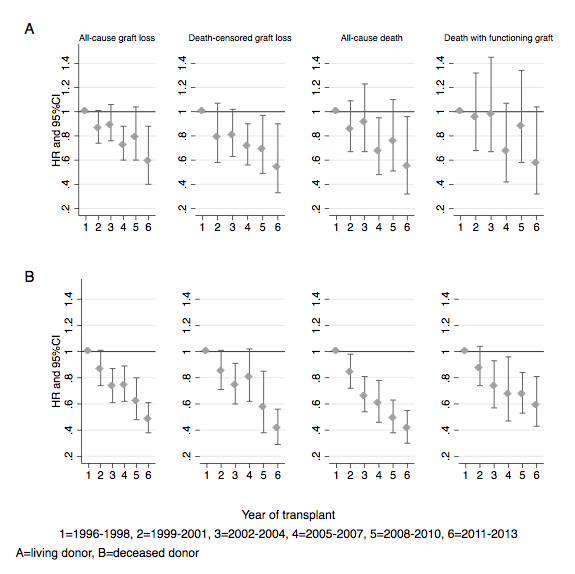Trends in Long-Term Outcomes of Kidney Transplantation in Australia and New Zealand.
1Sir Charles Gairdner Hospital, Perth, Australia
2St George Hospital, Sydney, Australia
3Princess Alexandra Hospital, Brisbane, Australia
4Royal Prince Alfred Hospital, Sydney, Australia
5University of Adelaide, Adelaide, Australia
6University of Queensland, Brisbane, Australia
7Westmead Hospital, Sydney, Australia
Meeting: 2017 American Transplant Congress
Abstract number: D254
Keywords: Graft survival, Kidney transplantation, Mortality, Outcome
Session Information
Session Name: Poster Session D: Long Term Kidney Outcomes
Session Type: Poster Session
Date: Tuesday, May 2, 2017
Session Time: 6:00pm-7:00pm
 Presentation Time: 6:00pm-7:00pm
Presentation Time: 6:00pm-7:00pm
Location: Hall D1
Introduction: Surgical and medical advances have led to considerable improvement in short-term outcomes of kidney transplantation, with 1-year graft and patient survival approaching 100%. However, the relationship between these changes and long-term patient and graft outcomes remains unclear. Methods: This longitudinal study included all children and adults who underwent first living ([LD] N=4596) or deceased ([DD] N=6915) donor kidney transplant surgery in Australia and New Zealand from January 1996 and December 2013. Risk factors for all-cause and death-censored graft loss, and death were analysed by multivariable Cox regression using era at the time of transplantation (1996-1998, 1999-2001, 2002-2004, 2005-2007, 2008-2010 and 2011-2013). Results: Compared to era 1 (1996-1998), patients transplanted in eras 2-6 were more likely to be older; have diabetes and coronary artery disease; receive kidneys from older donors, circulatory death and expanded criteria donors; have more HLA mismatches; and receive anti-CD25 monoclonal antibody and be treated with tacrolimus over cyclosporine and mycophenolate over azathioprine. Over a median follow-up of 6.6 yrs, 1089 LD and 2330 DD grafts were lost and 523 LD and 1581 DD recipients died. Compared to era 1, 5- and 10-year all-cause and death-censored graft survival rates over eras 2-6 improved among both LD and DD transplant recipients (logrank test for trend P<0.001). While 5- and 10-year patient survival rates improved among DD recipients (P<0.001), they remained unchanged among LD recipients (P=0.4). The hazard ratio for graft loss and death after LD and DD kidney transplantation are described in the figure. Conclusion: There have been significant improvements long-term graft and patient survival outcomes in both LD and DD kidney transplant recipients. 
CITATION INFORMATION: Lim W, Yeung W.-C, Campbell S, Chadban S, Clayton P, Hawley C, Johnson D, McDonald S, Pascoe E, Wong G, Badve S. Trends in Long-Term Outcomes of Kidney Transplantation in Australia and New Zealand. Am J Transplant. 2017;17 (suppl 3).
To cite this abstract in AMA style:
Lim W, Yeung W-C, Campbell S, Chadban S, Clayton P, Hawley C, Johnson D, McDonald S, Pascoe E, Wong G, Badve S. Trends in Long-Term Outcomes of Kidney Transplantation in Australia and New Zealand. [abstract]. Am J Transplant. 2017; 17 (suppl 3). https://atcmeetingabstracts.com/abstract/trends-in-long-term-outcomes-of-kidney-transplantation-in-australia-and-new-zealand/. Accessed December 14, 2025.« Back to 2017 American Transplant Congress
